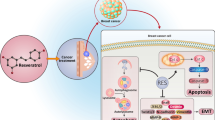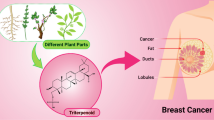Abstract
Cervical cancer represents the largest cause of mortality in women worldwide. In our previous report, we have shown how alpha-linolenic acid (ALA), an omega-3 fatty acid, regulated the growth of cervical cancer cells. The present study aimed to explore mechanistic details for the anticancer activity of ALA in cervical cancer cell lines, SiHa and HeLa. ALA significantly modulated the growth kinetics of the cells and reduced cell migration with concomitant decrease in the expression of VEGF, MMP-2, and MMP-9 proteins. Besides this, ALA significantly decreased the expression of phosphorylated p38, pERK1/2, c-JUN, NFκB, and COX2, proteins. Most importantly, ALA reduced the expression of HPV onco-proteins E6 and E7, resulting into restoration of expression of tumor suppressor proteins, p53 and Rb. These results suggested that ALA could be explored for its therapeutic potential in cervical cancer.









Similar content being viewed by others
References
Bruni L. ICO Information Centre on HPV and Cancer (HPV Information Centre). Human Papillomavirus and Related Diseases in the World Summary Report 2014.
Jing K, Shin S, Jeong S, Kim S, Song KS, Park JH, Heo JY, Seo KS, Park SK, Kweon GR, Wu T, Park JI, Lim K. Docosahexaenoic acid induces the degradation of HPV E6 / E7 oncoproteins by activating the ubiquitin–proteasome system. Cell Death Dis; 2014:1–11.
Shillitoe EJ. Papillomaviruses as targets for cancer gene therapy. Cancer Gene Ther. 2006;13:445–50.
Yeung CLA, Tsang TY, Yau PL, Kwok TT. Human papillomavirus type 16 E6 induces cervical cancer cell migration through the p53 / microRNA-23b / urokinase-type plasminogen activator pathway. Oncogene;2011: 1–10.
Nevins JR. The Rb/E2F pathway and cancer. Hum Mol Genet. 2001;10:699–703.
Sinha R, De A, Greenwald P. Cancer risk and diet in India. J Postgrad Med. 2003;49:222–8.
García-Closas R, Castellsagué X, Bosch X, González CA. The role of diet and nutrition in cervical carcinogenesis. A Rev Recent Ev Int J Cancer. 2005;117(4):629–37.
Bougnoux P, Hajjaji N, Maheo K, Couet C, Chevalier S. Fatty acids and breast cancer: sensitization to treatments and prevention of metastatic re-growth. Prog Lipid Res. 2010;49:76–86.
Aggarwal BB, Ichikawa H, Garodia P, Weerasinghe P, Sethi G, Bhatt ID, et al. From traditional Ayurvedic medicine to modern medicine: identification of therapeutic targets for suppression of inflammationand cancer. Expert Opin Ther Targets. 2006;10(1):87–118.
Mansara PP, Deshpande RA, Vaidya MM, Kaul-Ghanekar R. Differential ratios of omega fatty acids (AA/EPA + DHA) modulate growth, lipid peroxidation and expression of tumor regulatory MARBPs in breast cancer cell lines MCF7 and MDA-MB-231. PLoS ONE. 2015;10(9), e0136542.
Mansara PP, Ketkar M, Deshpande R, Chaudhary A, Shinde K, Kaul-Ghanekar R. Omega-3 fatty acid supplementation in breast cancer patients undergoing chemotherapy improved their antioxidant status—a case series. J Med Case Reports. 2015;9:148.
Stark AH, Crawford MA, Reifen R. Update on alpha-linolenic acid. Nutr Rev. 2008;66:326–32.
Burdge GC, Calder PC. Conversion of α-linolenic acid to longer-chain polyunsaturated fatty acids in human adults. Reprod Nutr Dev. 2005;45:581–97.
Kim JY, Park HD, Park E, Chon JW, Park YK. Growth-inhibitory and proapoptotic effects of alpha-linolenic acid on estrogen-positive breast cancer cells. Ann N Y Acad Sci. 2009;1171:190–5.
Chamberland JP, Moon HS. Down-regulation of malignant potential by alpha linolenic acid in human and mouse colon cancer cells. Familial Cancer. 2015;14:25–30.
Moon HS, Batirel S, Mantzoros CS. Alpha linolenic acid and oleic acid additively down-regulate malignant potential and positively cross-regulate AMPK/S6 axis in OE19 and OE33 esophageal cancer cells. Metabolism. 2014;63:1447–54.
Horia E, Watkins BA. Comparison of stearidonic acid and a-linolenic acid on PGE2 production and COX-2 protein levels in MDA-MB-231 breast cancer cell cultures. J Nutr Biochem. 2005;16:184–92.
Deshpande R, Mansara P, Suryavanshi S, Kaul-Ghanekar R. Alpha-linolenic acid regulates the growth of breast and cervical cancer cell lines through regulation of NO release and induction of lipid peroxidation. J Mol Biol. 2013;2:6–17.
Wani KD, Kadu BS, Mansara P, Gupta P, Deore AV, Chikate RC, et al. Synthesis, characterization and in vitro study of biocompatible cinnamaldehyde functionalized magnetite nanoparticles (CPGF Nps) for hyperthermia and drug delivery applications in breast cancer. PLoS One. 2014;9:107315.
Gebäck T, Schulz MM, Koumoutsakos P, Detmar M. TScratch: a novel and simple software tool for automated analysis of monolayer wound healing assays. Biotechniques. 2009;46:265–74.
Koppikar SJ, Choudhari AS, Suryavanshi SA, Kumari S, Chattopadhyay S. Aqueous Cinnamon Extract (ACE- c) from the bark of Cinnamomum cassia causes apoptosis in human cervical cancer cell line (SiHa) through loss of mitochondrial membrane potential, BMC Cancer; 2010.
Morandell D, Kaiser A, Herold S, Rostek U, Lechner S, Mitterberger MC, et al. The human papillomavirus type 16 E7 oncoprotein targets Myc-interacting zinc- finger protein-1. Virology. 2012;422:242–53.
Domenico FD, Foppoli C, Coccia R, Perluigi M. Antioxidants in cervical cancer: chemopreventive and chemotherapeutic effects of polyphenols. Biochim Biophys Acta (BBA) - Mol Basis Dis. 1822;2012:737–47.
Hagemann T, Bozanovic T, Hooper S, Ljubic A, Slettenaar VI, Wilson JL, et al. Molecular profiling of cervical cancer progression. Br J Cancer. 2007;96(2):321–8.
Ueda M, Terai Y, Yamashita Y, Kumagai K, Ueki K, Yamaguchi H, et al. Correlation between vascular endothelial growth factor-C expression and invasion phenotype in cervical carcinomas. Int J Cancer. 2002;321:335–43.
Behren A, Simon C, Schwab RM, et al. Papillomavirus E2 protein induces expression of the matrix metalloproteinase-9 via the extracellular signal-regulated kinase / activator protein-1 signaling pathway kinase / activator protein-1 signaling pathway. Cancer Res. 2005;65:11613–21.
Huang AC, Hsu SC, Kuo CL, Liao CL, Lai KC, Lin TP, et al. Involvement of matrix metalloproteinases in the inhibition of cell invasion and migration through the inhibition of NF- κ B by the New synthesized ethyl 2-[N-p-chlorobenzyl-(2’-(JOTO1007) in human cervical cancer Ca Ski cells. In Vivo. 2009;620:613–9.
Brooks SA, Lomax-Browne HJ, Carter TM, Kinch CE, Hall DM. Molecular interactions in cancer cell metastasis. Acta Histochem. 2010;112:3–25.
Choudhari AS, Suryavanshi S, Kaul-Ghanekar R. The aqueous extract of Ficus religiosa induces cell cycle arrest in human cervical cancer cell lines SiHa (HPV-16 Positive) and apoptosis in HeLa (HPV-18 positive). PLoS One. 2013;8:e70127.
Shen L, Shui Y, Wang X, Sheng L, Yang Z, Xue D, et al. EGFR and HER2 expression in primary cervical cancers and corresponding lymph node metastases: implications for targeted radiotherapy. BMC Cancer. 2008;8:232.
Menéndez JA, Vázquez-Martín A, Ropero S, Colomer R, Lupu R. HER2 (erbB-2)-targeted effects of the omega-3 polyunsaturated fatty acid, alpha-linolenic acid (ALA; 18:3n-3), in breast cancer cells: the “fat features” of the “Mediterranean diet” as an “anti-HER2 cocktail”. Clin Transl Oncol. 2006;8(11):812–20.
Mason JK, Klaire S, Kharotia S, Wiggins AK. Thompson LU.α-linolenic acid and docosahexaenoic acid, alone and combined with trastuzumab, reduce HER2-overexpressing breast cancer cell growth but differentially regulate HER2 signaling pathways. Lipids Health Dis. 2015;14(1):91.
Subbaramaiah K, Dannenberg AJ. Cyclooxygenase-2 transcription is regulated by human papillomavirus 16 E6 and E7 oncoproteins: evidence of a corepressor / coactivator exchange of a corepressor / coactivator exchange. Cancer Res. 2007;15:3976–85.
James MA, Lee JH, Klingelhutz AJ. Human papillomavirus type 16 E6 activates NF-κ B, induces cIAP-2 expression, and protects against apoptosis in a PDZ binding motif-dependent manner human papillomavirus type 16 E6 activates NF-B, induces cIAP-2 expression, and protects against Apo. J Virol. 2006;80:5301–7.
Kim S, Oh J, No J, Bang J, Juhnn Y, Song Y. Involvement of NF- k B and AP-1 in COX-2 upregulation by human papillomavirus 16 E5 oncoprotein. Carcinogenesis. 2009;30:753–7.
Gagnon V, Parent S, Asselin E. Regulation of COX-2 protein expression by Akt in endometrial cancer cells is mediated through NF-κB/IκB pathway. Mol Cancer. 2004;11:1–11.
Chaturvedi MM, Sung B, Yadav V R, Kannappan R, and Aggarwal BB. NF- κB addiction and its role in cancer:one size does not fit all.Oncogene;2010:1–16
Kim SH, Juhnn YS, Kang S, Park SW, Sung MW, Bang YJ, et al. Human papillomavirus 16 E5 up-regulates the expression of vascular endothelial growth factor through the activation of epidermal growth factor receptor, MEK / ERK1, 2 and PI3K / Akt. Cell Mol Life Sci. 2006;63:930–8.
Branca M, Ciotti M, Santini D, Di Bonito L. Activation of the ERK / MAP kinase pathway in cervical intraepithelial neoplasia is related to grade of the lesion but not to high-risk human papillomavirus, virus clearance, or prognosis in cervical cancer. Am J Clin Pathol. 2004;122:902–11.
Roberts PJ, Der CJ. Targeting the Raf-MEK-ERK mitogen-activated protein kinase cascade for the treatment of cancer. Oncogene. 2007;26:3291–310.
Olson JM, Hallahan AR. p38 MAP kinase: a convergence point in cancer therapy. Trends Mol Med. 2004;10:125–9.
Mason JK, Fu MH, Chen J, Yu Z, Thompson LU. Dietary flaxseed-trastuzumab interactive effects on the growth of HER2-overexpressing human breast tumors (BT-474). Nutr Cancer. 2013;65(3):451–9.
Weiss C, Bohmann D. Deregulated repression of c-Jun provides a potential link to its role in tumorigenesis. Cell Cycle. 2004;3:111–3.
Yamaguchi K, Lantowski A, Dannenberg AJ, Subbaramaiah K. Histone deacetylase inhibitors suppress the induction of c-Jun and its target genes including COX-2. J Biol Chem. 2005;280:32569–77.
Tan S, De Vries EG, van der Zee AG, de Jong S. Anticancer drugs aimed at E6 and E7 activity in HPV-positive cervical cancer. Curr Cancer Drug Targets. 2012;12:170–84.
Chinnam M, Goodrich D. RB1 development, and cancer. Curr Top Dev Biol. 2011;94:129–69.
Stanley MA, Pett MR, Coleman N. HPV : from infection to cancer. Biochem Soc Trans. 2007;35(6):1456–60.
Das UN, Madhavi N, Sravan Kumar G, Padma M, Sangeetha P. Can tumour cell drug resistance be reversed by essential fatty acids and their metabolites? Prostaglandins Leukot Essent Fat Acids. 1998;58:39–54.
Sangeetha P, Das UN, Koratkar R, Ramesh G, Padma M. Cytotoxic action of cis-unsaturated fatty acids on human cervical carcinoma (HeLa) cells: relationship to free radicals and lipid peroxidation and its modulation by calmodulin antagonists. Cancer Lett. 1992;63:189–98.
Calder PC. Dietary modification of inflammation with lipids. Proc Nutr Soc. 2002;61:345–58.
Calder PC. Long-chain polyunsaturated fatty acids and inflammation. Scan J Food Nut. 2006;50:5461.
Ghosh C, Baker JA, Moysich KB, Rivera R, Brasure JR, McCann SE. Dietary intakes of selected nutrients and food groups and risk of cervical cancer. Nutr Cancer. 2008;60(3):331–41.
Acknowledgements
This work was supported by funding from the Interactive Research School for Health Affairs (IRSHA), Bharati Vidyapeeth University. We thank our Director Dr. A. C. Mishra for supporting our work.
Author information
Authors and Affiliations
Corresponding author
Ethics declarations
Competing interests
The authors declare that there is no competing interests.
Electronic supplementary material
Below is the link to the electronic supplementary material.
ESM 1
(DOCX 20 kb)
Rights and permissions
About this article
Cite this article
Deshpande, R., Mansara, P. & Kaul-Ghanekar, R. Alpha-linolenic acid regulates Cox2/VEGF/MAP kinase pathway and decreases the expression of HPV oncoproteins E6/E7 through restoration of p53 and Rb expression in human cervical cancer cell lines. Tumor Biol. 37, 3295–3305 (2016). https://doi.org/10.1007/s13277-015-4170-z
Received:
Accepted:
Published:
Issue Date:
DOI: https://doi.org/10.1007/s13277-015-4170-z




